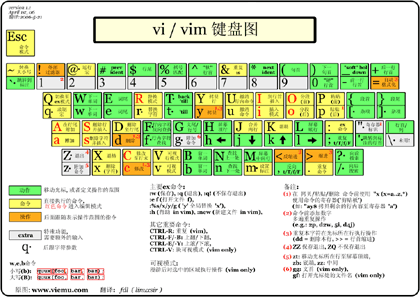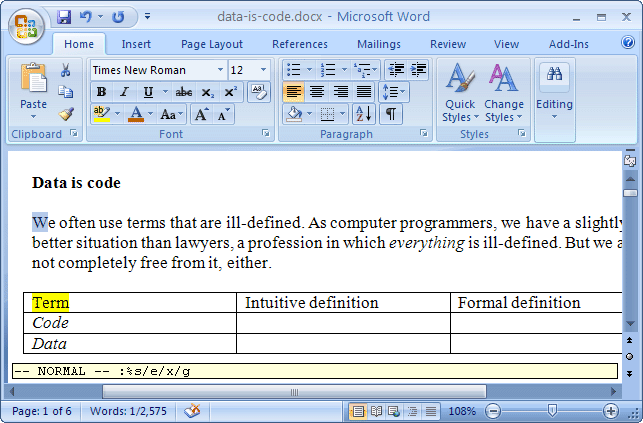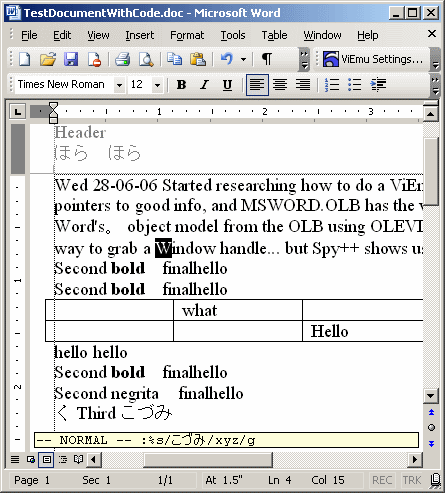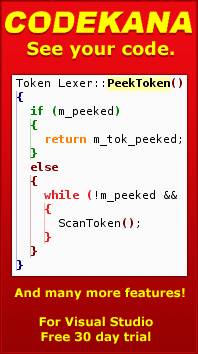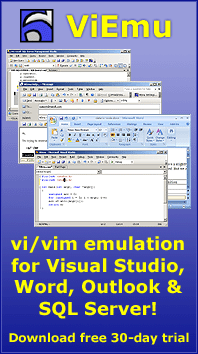Fact #1: I haven’t posted on the blog for well over a month. With all the pending things I have (ViEmu 2.0, the text editor, my day job obligations, support, etc…), I can hardly find time to do so. Promises not kept: the “Friggin’ Darn Tough/Functional Dynamic Template-based C++” series, an article on ViEmu I promised to Keith Casey from CodeSnipers, an article with cool graphical charts on the digg effect as seen from viemu.com (more on this below), etc… Hopefully everything will come along. Until I build the business to the point where it will sustain me, I really just can’t afford do put my available energy in anything other than improving & supporting ViEmu, and preparing the next product.
Fact #2: The final name for the NGEDIT text editor will be kodumi. I wanted a name that sounded good, and which wouldn’t be limiting for the future evolution of the product. It means “hacking” in Esperanto, although Esperanto is not, like, so widespread that the meaning is the important part. I like how it sounds and I can identify with it. It still works when the product becomes more than a text editor. If the product is really good, which I’m hoping it will, this should ensure the name sticks. I’m open to feedback and criticism. I’m pretty stubborn and it’s unlikely I’ll change it, though.
Fact #3: The next product I release probably won’t be the kodumi text editor. There is quite some work yet to be done with kodumi before 1.0, and I’ll probably release another product based in another functional part of the editing core, as a VS add-in. Hopefully with a much larger appeal than a vi emulator. It will actually be based in one of the innovative features I’m planning for kodumi 1.0. It’s nice to have a product that has several offspring before being born.
On the other hand, given that I will probably be releasing this product, it may make sense to have a single site for all VS add-ins instead of a separate one for each product (such as viemu.com). Oh well… this right after moving to viemu.com… so much for my strategy forecast skills.
Fact #4: The amount of traffic you get from a reddit / del.icio.us / digg front page is amazing. I’ve also got thousands of visitors from StumbleUpon.
Here are some graphics that show it, as the graphical vi/vim cheat sheet I released made it (twice!) to those front pages. I apologize for not being able to write a full article on this, it would be worth an entire study.
In order to understand these properly, take into account that originally ViEmu was hosted at ngedit.com, and I moved it to its own domain viemu.com together with the release of the cheat sheet. The traffic graphs include both domains, as they’re served from the same account, but the Alexa graphs below show both domains with separate lines.
I released the cheat sheet on March 28. Here is the traffic for that day (click for a full sized image):

You can clearly see the moment it picks up to 100kbps sustained. The climb was caused by it getting to reddit’s homepage, which happened about half an hour after I submitted it (people liked it, so they voted for it, making it reach the front page – it’s not against their guidelines to submit your own stuff).
The traffic before the climb used to be typically low – very nichey product, a few blog readers, etc… enough to result in some sales, but nothing big.
I went to bed as soon as I saw it at the bottom of reddit’s front page. The next day would be crazier.
As a side effect, people started bookmarking it to their del.icio.us account for later reference. This is understandable given the “reference” nature of the cheat sheet. As soon as a fair number of people did this, it also appeared in del.icio.us’ popular page, thus getting more traffic from there.
This is the traffic on the 29th:

I apologize for not presenting a higher-resolution sampling, I forgot to save it from my hosting provider, and I can’t generate it again.
Anyway, please take into account that the lowest bar in the graph is as high as the 100kbps high in the previous one. It was pretty amazing. I first watched it for hours no end in reddit’s and del.icio.us’ homepage, and a lot of traffic coming. But then I submitted it to digg, and watched it play the voting game in digg’s “sub leagues” (the system is very different from reddit). And then the big spike came: it made it to digg’s front page. All hell broke loose, bandwidth requirements grew to 2Mbps sustained, and the number of visitors was amazing. It made reddit and del.icio.us look like a joke.
My hosting provider handled it without a hiccup. On the other hand, that very afternoon after submitting to digg, (1) there was a power outage at my building, (2) when it came back, my DSL service was down and unfixable according to my ISP, (3) I got a flat tire when driving to a friends’ in order to watch the digg effect, and mainly to be on the watch in case bandwidth went beyond the monthly limit, which happened, so (4) I had to upgrade my web hosting account. You can say I had all the hiccups web servers usually have in these cases.
Here you can see the traffic for the next two days:


You can see the long tail of the digg effect. Also, the cheat sheet got linked from many places around the web, and StumbleUpon started to pick it up as well.
Here you can see a graph of all of March’s traffic, a nice picture of the reddit, del.icio.us & digg effects:

And here is a glorious graph of all of 2006’s traffic:

I promise that I had traffic before March 29, even if here it’s squashed into oblivion!
Finally, I’ll bring you some captures of what alexa thinks of my domains (it doesn’t know they are related somehow).
First, here is the Alexa’s “Daily Reach” measure, for the last 12 months, 6 months and 3 months (just for your static zooming enjoyment):
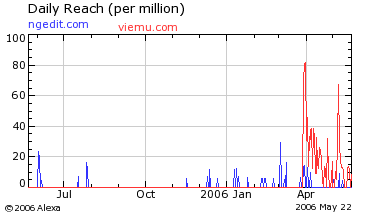
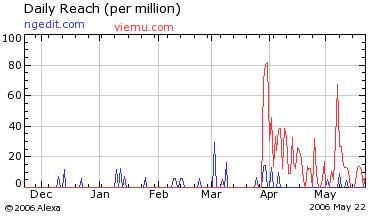
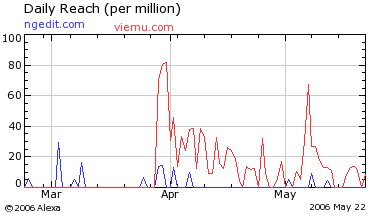
I can almost tell you where each spike comes from: the first one, in May last year, comes from Eric Sink’s kind mention of my blog & NGEDIT. The second one comes after the release of ViEmu. The largish one before the digg effect comes from a mention in Bungie’s web newsletter (which, expectedly, led to thousands of hardcore gamers, only one of whom was courageous enough to actually download ViEmu), etc…
I chose to show the daily reach above just because it is the Alexa measurement which best shows the evolution of my web presence. Their best known stat is the “rank”, which ranks the site globally among all websites. They only plot it for the top 100,000 sites, but they give you the number in any case. Here are the graphs of the rank, for the last 12 and 3 months:
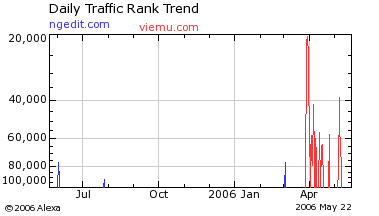
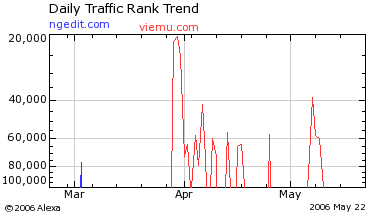
Actually, the second large spike you can see earlier this month was due to the cheat sheet making it once again to digg and del.icio.us’ front pages, this time as a direct link to the cheat sheet’s GIF file.
Amidst all of this traffic madness, there is another important source of visitors which is often overlooked. I know I did. The name is StumbleUpon. This is not a social links site, but a plugin that you install to your browser, and with which you both (a)vote sites up or down, and (b)discover sites other stumblers’ liked. The effect is much slower, but the amount of visitors it can bring during a few weeks competes with the likes of reddit and digg.
In order to show this better, I will show some visitor numbers by referrer (only for viemu.com). I’ve decided not to totalize them by domain, as the distribution of source pages also provides some interesting info. I haven’t included many other sources, generated from bloggers, news sites and site owners discovering it and linking to them.
March
Total unique visitors: 22,901
| http://www.digg.com |
3910 |
| http://digg.com |
3210 |
| http://digg.com/programming/vi_vim_Graphical_Cheat_Sheet_Tutoria… |
2665 |
| http://www.digg.com/index/page2 |
543 |
| http://www.digg.com/index/page3 |
631 |
| http://www.digg.com/index/page4 |
238 |
| http://www.digg.com/index/page5 |
95 |
| http://digg.com/index/page2 |
398 |
| http://digg.com/index/page3 |
500 |
| http://digg.com/index/page4 |
184 |
| http://digg.com/programming |
141 |
| http://www.digg.com/programming |
141 |
|
| http://reddit.com |
1814 |
|
| http://del.icio.us/popular/ |
1116 |
| http://del.icio.us |
112 |
| http://www.stumbleupon.com/refer.html |
120 |
|
| http://popurls.com |
392 |
| http://diggdot.us |
154 |
April
Total unique visitors: 20,429
| http://www.stumbleupon.com/refer.html |
7858 |
|
| http://digg.com/programming |
127 |
| http://www.digg.com/programming |
121 |
| http://digg.com/programming/page2 |
69 |
| http://digg.com/programming/vi_vim_Graphical_Cheat_Sheet_Tutoria… |
376 |
| http://www.digg.com/search |
68 |
|
| http://del.icio.us |
104 |
| http://del.icio.us/search/ |
70 |
|
| http://hedera.linuxnews.pl/_news/2006/04/03/_long/3795.html |
1883 |
| http://www.linuxnews.pl |
556 |
| http://linuxnews.pl |
536 |
| http://www.wykop.pl |
216 |
May
Total unique visitors: 6,208 (this doesn’t count those coming through the GIF link as that is not considered a “page” by awstats)
| http://www.stumbleupon.com/refer.html |
805 |
|
| http://digg.com/programming/vi_vim_Graphical_Cheat_Sheet_Tutoria… |
133 |
| http://www.digg.com/programming/vi_vim_Graphical_Cheat_Sheet_Tut… |
53 |
| http://digg.com/search |
36 |
| http://digg.com/search/page2/ |
19 |
|
| http://del.icio.us/search/ |
45 |
Just for fun, I have included the links from several sites in Poland during April. For some reason it was very popular there during that month. Maybe vi/vim is better suited to heavily accented languages like Polish?
Fact #5: I’d need to sell about 1.5x to 2x as much as I’m selling now to live off of the income from ViEmu. Not a big success 10 months after release. It’s ok, as I’ve learned a lot from the experience, and I needed to do most of it for kodumi anyway, which is the main goal. At least for the kodumi I want to develop and release.
Fact #6: vi/vim emulation for VS is not for the masses. I have gotten over 50k visitors to the site in the past two months. This is about more than 20x as much as I was getting beforehand. I guess a product with a more general appeal would have noticed an enormous spike in sales. I’ve only seen a smallish upwards trend. Even VS users are a minority among vi/vim fans! I’ve sworn not to switch over to a Dvorak keyboard layout until the business really takes off, I could end up targeting an even smaller market!
Fact #7: I don’t understand Google results. I’m on page number one for “vim tutorial”, but nowhere to be seen for “vi tutorial”. I was extra careful to write “vi/vim graphical cheat sheet and tutorial” everywhere, so that I would be found by any of the likely keywords, and the result is so bad it’s sick. Searching for “vi emulation visual studio” gets the old page, even if there are links to www.viemu.com all over the place. If there’s a sandbox, I don’t understand why it affects some keywords and not others. Is “vi” too short? Then how did my SEO work before with the ngedit.com address? I’m starting to experiment with creative redirections to the new site, but I’m going to do it the slow way in order to cut the losses in case Google doesn’t like my playing around.
Fact #8: it was cool to have the vi/vim cheat sheet translated into simplified Chinese by Donglu Feng, a nice guy who sent it over to me. It makes regular vi/vim seem a piece of cake:
